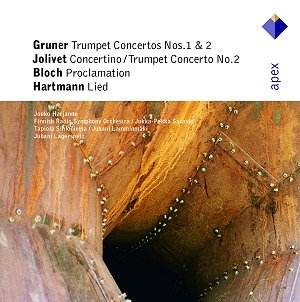Maurice André has long championed
Jolivet’s trumpet concertos which he recorded with the composer
conducting. Since then, other younger players (Wynton
Marsalis and Jouko Harjanne,
to mention but two) have brilliantly followed suit. The Concertino
of 1948 was written as a test piece for the Paris Conservatoire and
is a quite accessible work in variation form; but, it nevertheless puts
a number of technical and expressive demands on the player, be it in
animated, rhythmically intricate episodes or in passages calling for
effortless cantabile playing. The Concertino is
Jolivet at his most approachable. The Second
Trumpet Concerto, written for André, is scored for a small wind ensemble
including two saxophones, harp, piano, double bass and piano - a sophisticated
jazz band. Jazzy inflections permeate the work, be it in the rhythmically
alert outer movements or in the slow movement. Varèse, who had a lasting influence on Jolivet,
is also recalled in the innovative use of percussion. The Second Trumpet
Concerto is a brilliant display of virtuosity as well as of compositional
originality. (Jolivet composed two other pieces
for Maurice André: Arioso Barocco
for trumpet and organ, and Heptade
for trumpet and percussion.)
Hartmann’s Lied
for trumpet and wind ensemble is the slow movement of his Concertino
completed in 1933, withdrawn and reworked some time later as the second
movement of the Fifth Symphony Sinfonia Concertante (1951). The
most striking feature of this short piece is the bassoon’s main theme,
a (near) quotation of the opening of Stravinsky’s Rite of Spring,
possibly as a tribute from the young composer to his illustrious and
influential older colleague.
Bloch’s Proclamation
is a late work written in 1955, during the composer’s last decade -
the same era that produced the Symphony for Trombone and Orchestra
(1954). True to its title, this short piece is declamatory and in the
nature of a ritual invocation. LP collectors may remember that it was
once available in a pioneering Louisville disc.
Berlin-born Joachim Gruner,
whose name and music are new to me, is a professional percussionist
and, from the 1960s onward, a composer of several concertos. His First
Trumpet Concerto of 1986, in three movements (Arlecchino,
Ballet and Carneval), is a virtuoso
piece of great verve suggesting, to a certain extent, the atmosphere
of a carnival. The music also has its darker, more enigmatic moments.
On the other hand, the Second Concerto is, on the whole, more abstract
but very much in line with its predecessor, stylistically speaking.
Gruner’s music is fairly traditional, in 20th Century
terms, mildly expressionistic but quite accessible. It is also superbly
crafted and expertly written for the instrument. Gruner’s
trumpet concertos, that were both first performed
by Harjanne, might soon become standards in the trumpet’s
repertoire. This is much finer stuff than, say, Arutiunian’s
ubiquitous, but rather bland concerto.
Harjanne’s playing is simply stunning, immaculate and seemingly effortless. Excellent
orchestral playing and recording (just try the opening of Jolivet’s
Second Concerto). A most welcome release, and
my Bargain of the Month.
Hubert Culot

![]() Jouko Harjanne (trumpet); Finnish Radio Symphony Orchestra; Jukka-Pekka Saraste; Tapiola Sinfoniettaa;
Juhani Lamminmäki a
Jouko Harjanne (trumpet); Finnish Radio Symphony Orchestra; Jukka-Pekka Saraste; Tapiola Sinfoniettaa;
Juhani Lamminmäki a
![]() WARNER
APEX 0927 43935-2 [72:37]
WARNER
APEX 0927 43935-2 [72:37]